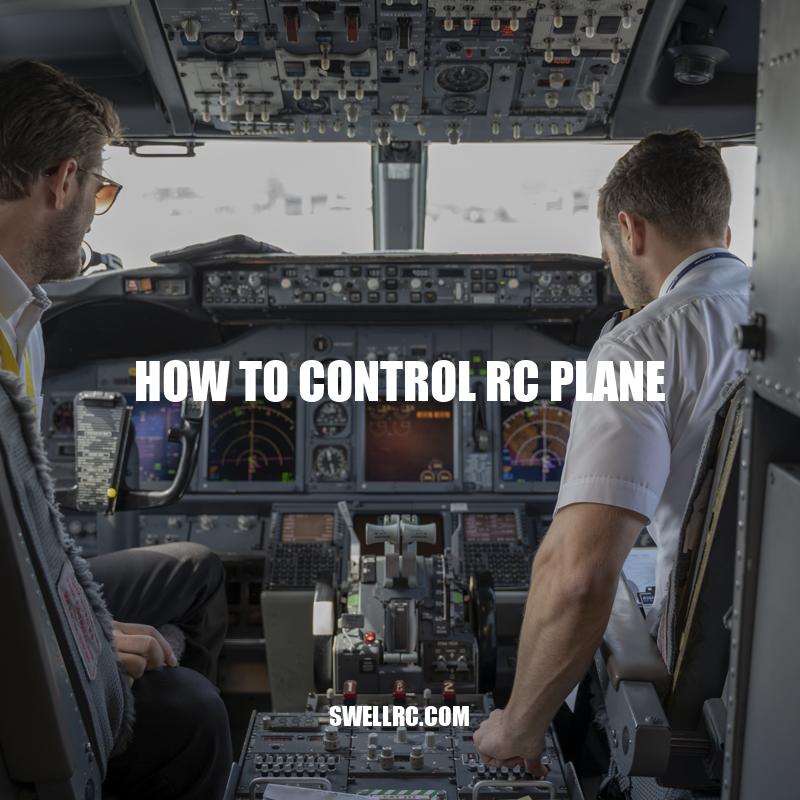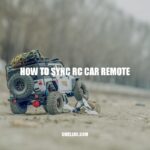Mastering RC Plane Control: Essential Tips for Safe Flight
RC planes are an exciting hobby that can provide hours of fun, and for many, a lifelong passion. But before you can enjoy the thrill of soaring through the skies with an RC plane, it’s essential to learn how to control it. Without the proper knowledge, flying an RC plane can be frustrating, and can even lead to accidents. Learning how to control an RC plane successfully brings confidence, and it ensures that you get the most out of your investment. This article offers a step-by-step guide to help you develop the skills and knowledge necessary to control your RC plane safely. It will cover everything from understanding the components of an RC plane to performing advanced maneuvers, giving you everything you need to know to become a skilled RC pilot. But first, let’s talk about the importance of knowing how to control an RC plane.
Understanding the Components of RC Plane
Before you can start controlling the RC plane, you need to understand its individual components. Here are the main components of an RC plane:
- Transmitter: This is the radio controller used to give instructions to the plane. It is a handheld device shaped like a remote control with joysticks to control the aircraft.
- Receiver: This receives the signals sent from the transmitter and passes them on to the servos.
- Servos: These are small motors attached to the control surfaces of the airplane, such as the wings and the tail. They move the control surfaces as per the instructions from the receiver.
- Battery: It powers the receiver, transmitter, and servos.
- Channels: These are the control inputs of the transmitter used to operate the servos.
Understanding these components and their roles is essential in mastering the control of your RC plane. If you want an in-depth knowledge of these components, check out the manufacturer’s website or attend an RC-planes workshop.
What Parts Do You Need for an RC Plane?
If you’re thinking about building an RC plane, you’ll need a few key parts to get started. Here are the essentials:
- Aircraft kit or plans
- Radio control system (transmitter and receiver)
- Engine or motor
- Battery
- Electronic speed control (ESC)
- Servos
- Propeller
- Building materials (balsa wood, foam, glue, etc.)
Some websites to check out for RC plane parts include Tower Hobbies, Horizon Hobby, and HobbyKing. These sites offer a wide range of products and resources for RC plane enthusiasts.
Getting Started with RC Plane
After understanding the components of an RC plane, you need to get it ready for its maiden flight. Here are the steps you need to follow:
| Pre-Flight Checklist | Description |
|---|---|
| Battery | Inspect the battery and ensure it is fully charged. |
| Control surfaces | Check the movements of the control surfaces to ensure they are functioning properly. |
| Range test | Ensure that the aircraft and transmitter are communicating effectively. |
| Wind conditions | Fly in calm weather conditions with winds not exceeding 10 mph. |
Other things to consider include:
- Find a suitable location with ample space to fly the plane away from people, trees, and buildings.
- Use a checklist to ensure every preparatory step is complete.
- Consider purchasing an RC Flight Simulator to practice flying the aircraft using a computer.
By taking these steps, you ensure that your aircraft is in perfect condition to perform its first flight.
How do you fly an RC plane for the first time?
If you’re planning to fly an RC plane for the first time, here’s what you need to know:
- Choose a calm and clear day to fly your plane.
- Find a large open area free from trees and obstacles.
- Set up your RC plane according to the manufacturer’s instructions.
- Check the control surfaces and make sure they move correctly.
- Before takeoff, stand behind the plane and ensure that the controls are responsive and functioning properly.
- Begin with a low throttle and try to keep the plane at a steady altitude.
- Practice making turns by gently moving the control stick to the left or right.
- If you feel like you’re losing control, reduce the throttle and let the plane glide.
- Practice landing your plane by reducing the throttle and gently guiding it towards the ground.
Remember, flying an RC plane takes practice, so don’t be discouraged if things don’t go perfectly the first time. And if you’re looking for more information or advice, there are many forums and websites dedicated to the RC hobby, such as rcgroups.com and horizonhobby.com.
Basic Controls of RC Plane
After getting your aircraft ready, it’s time to learn the basic controls of an RC plane. These basic steps include:
Throttle
- To speed up, push the throttle stick forward, and to slow down, pull it backwards.
- The throttle controls the power to the propeller or motor, and maintaining speed is essential.
Elevator
- The elevator control affects the pitch or angle of the plane’s nose.
- To make the plane go up or climb, you must move the elevator stick down.
- Conversely, to make the plane dive or descend, you need to move the stick up.
Rudder
- The rudder control affects the yaw or horizontal direction of the plane.
- To make the plane turn left or right, you must move the rudder stick to the left or right, respectively.
Ailerons
- The ailerons affect the roll, or the banking of the aircraft.
- If you want the plane to roll left, push the left aileron stick upwards, and vice versa.
These are the fundamental controls that pilots must master before progressing to advanced maneuvers.
There are many resources available for those looking to learn how to control an RC plane. There are online tutorials, videos, and forums that provide valuable information and insights about the hobby. Additionally, manufacturers such as Horizon Hobby and HobbyZone offer a range of beginner-level RC planes and guides to help new pilots get started.
What are the controls on a RC plane?
The controls on a RC plane are as follows:
- Throttle control
- Elevator control
- Aileron control
- Rudder control
The throttle control manages the speed of the plane, while the elevator control adjusts the pitch of the plane’s nose. The aileron control is responsible for banking or tilting the plane, while the rudder control manages the direction of the plane. For more information on RC planes, check out websites such as Horizon Hobby or products such as the HobbyZone Sport Cub S2.
Advanced Maneuvers
Once you’re familiar with the basic controls of an RC plane, you can progress to advanced maneuvers. However, it’s important to remember that mastering the fundamental controls is crucial before attempting them. Here are some common advanced maneuvers to learn:
Banking
- Banking the plane means tilting it on its side, creating a turn.
- Speed should be maintained during banking maneuvers, as reduced speed can lead to a stall.
Loop
- A loop involves a complete 360-degree turn in one vertical plane.
- Gaining altitude before a loop is recommended since it loses speed as the plane climbs.
Roll
- A roll is when the plane flips on its axis, making it turn 360 degrees parallel to the ground.
- It’s essential to maintain speed to avoid stalling.
Remember, these maneuvers can be challenging, and it takes practice to master them. Always perform these at a safe distance and altitude to prevent crashes.
There are various resources online that provide further information about advanced maneuvers, including videos and tutorials. Many online communities may also offer advanced tips and techniques on how to control an RC plane. Furthermore, certain RC plane models, such as the E-flite Carbon Cub S+ feature advanced features like SAFE technology, which helps pilots perform advanced maneuvers with less risk.
How are control surfaces controlled on an RC plane?
Control surfaces on an RC plane are controlled through the use of a transmitter and receiver system. The transmitter sends signals to the receiver on the plane, which in turn activates servo motors that move the control surfaces. These servo motors are usually located near the control surfaces, and they are responsible for adjusting the surface’s angle to control the plane’s movement. Some RC planes also use flaps, which are special control surfaces that help to enhance the plane’s stability and control during takeoff and landing.
If you’re interested in learning more about RC planes, check out websites like RCGroups.com, FlyingGiants.com, or HobbyKing.com for more information and products.
Troubleshooting Common Issues
No matter how experienced you are in controlling an RC plane, you may encounter some problems while flying. Here are a few common issues and how to troubleshoot them:
Loss of Connection
- The RC plane may lose connection with the transmitter, leading to unresponsiveness.
- Another radio transmitter or a nearby Wi-Fi signal can cause interference.
- Move the transmitter or the RC plane to a different location, away from any potential interference.
Power Issues
- If the aircraft quits mid-flight, it could be due to the battery running out of power.
- Charge the battery fully before flying and monitor the power usage during the flight.
- Check the battery for any damages or deformities, and replace it if needed.
Mechanical Issues
- Loose or damaged control surfaces like the propellers, ailerons or the rudder can cause problems with control.
- Inspect the aircraft before and after each flight and tighten any loose screws.
- Replace any damaged parts.
If you’re uncertain about troubleshooting these problems, seek help from an experienced RC pilot. You can also find more information on RC plane communities and message boards. Certain RC plane models may have product-specific online forums and customer support.
How do I get better at RC planes?
Here are some tips to improve your skills in flying remote control planes:
- Join RC flying clubs or groups to connect with experienced pilots who can offer guidance and tips.
- Practice regularly with a simulator to improve your control and reaction time.
- Start with a trainer plane that’s specifically designed for beginners and work your way up to more advanced planes.
- Learn about weather conditions and how they affect flying, and avoid flying during strong winds or rain.
- Attend workshops or classes to improve your knowledge and skills in building and maintaining RC planes.
There are also many online resources available, such as forums, blogs, and YouTube channels dedicated to RC planes. Some popular websites and products to check out include RCGroups.com, FliteTest.com, and the RealFlight simulator.
Conclusion
Learning how to control an RC plane can provide you with endless hours of fun and entertainment. However, it requires patience and practice, especially for beginners. Keep in mind that safety should always be a top priority in every flight.
Use the tips provided in this article to familiarize yourself with the components of an RC plane, get started, practice basic controls, and master more advanced maneuvers. Troubleshoot common issues and maintain your RC plane for optimum performance.
By following these guidelines, you’ll be able to take your RC plane flying to new heights. Happy flying!



